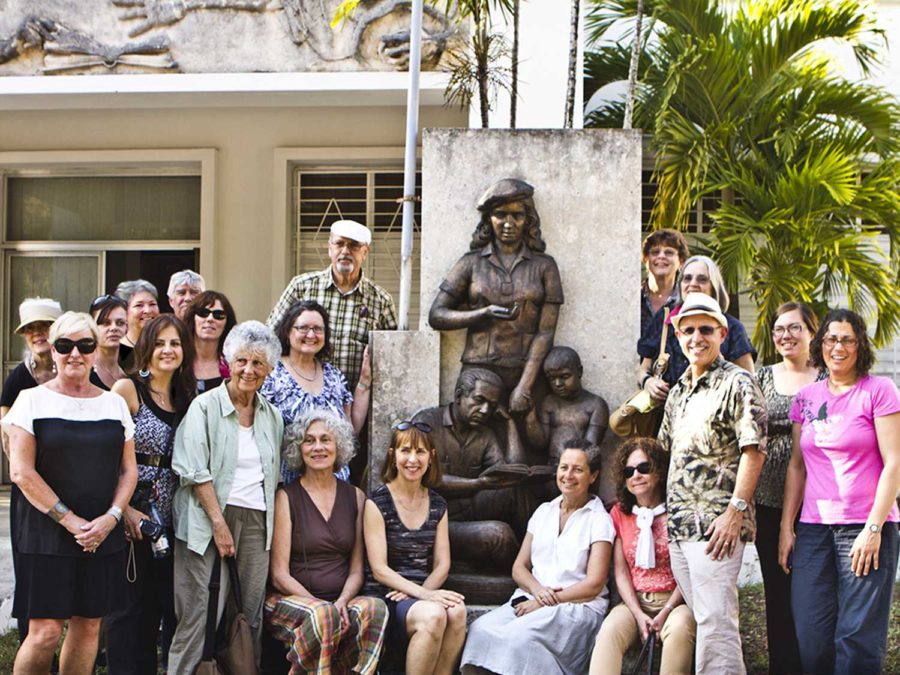Santa Rosa Junior College ESL Professor Gino Muzzatti traveled to 46 countries in his lifetime but there’s one place he’s always wanted to revisit: Cuba.
“I think Cuba is so unique. It’s sort of the forbidden fruit,” he said.
Muzzatti took the chance to revisit the island when he organized a cultural trip to the island for his friends and colleagues this spring break. Of the 27 people who traveled to Cuba with Muzzatti, 12 were current instructors and four previously taught at SRJC.
Muzzatti’s first taste of Cuba was in Spring 2011 when he visited the country with his son. Muzzatti stayed with a family in the country, which allowed him to “experience Cuba as the Cubans do.”
Shortly after returning from Cuba, Muzzatti went to a showing of the film “Maestra” in San Francisco. “Maestra” is a documentary following the women who participated in the Cuban Literacy Campaign in 1961. The campaign brought in 250,000 volunteers, most of whom were young girls. According to the film, 700,000 Cubans learned to read and write by the end of the year, making the campaign one of the most successful in Latin American history.
Muzzatti’s first trip to Cuba, paired with the viewing of “Maestra,” became the catalyst for developing SRJC’s Cuban Film & Music Festival that took place March 27-30. He was also inspired to plan another trip to Cuba, but this time Muzzatti wanted to take a group of people along for the ride. He immediately generated interest from friends and co-workers for the second trip.
SRJC political science instructor Jeanette Benfarhat was one of the instructors who traveled to Cuba with Muzzatti.
“I saw Gino when I was coming out of my Spanish class and he told me that he was going to lead this trip,” Benfarhat said. “I knew whatever Gino was involved in, I wanted to go.”
Benfarhat and Muzzatti first met on a trip to Italy a few years ago. Like Muzzatti, Benfarhat travelled around the globe to places like Egypt, India and Peru.
Cuba can be regarded as the “forbidden fruit” by many Americans due to the sanctions the United States placed on the country. The U.S. imposed regulations on trade and travel to Cuba in July 1963 with the Cuban Assets Control Regulations. The Office of Foreign Assets Control (OFAC) manages these restrictions, which apply to American citizens and all entities branched from the United States.
Those restrictions are still in place today, as Cuba-bound Americans wishing to travel to the island republic are required to obtain a license from OFAC. Licenses are granted if an individual fits into specific categories. Government officials traveling on official business, free-lance journalists conducting research and people visiting family are examples of people who can apply for licenses.
Due to travel restrictions, the group had to go to Cuba through what are known as “People-to-People Groups.” These groups are licensed by OFAC and are authorized to organize travel to Cuba for groups. Still, those traveling must comply with requirements such as having an itinerary with educational events planned for each day of the trip.
Global Exchange was the People-to-People group that hosted the trip to Cuba. Rebekah Olstad works for Global Exchange and coordinated the Reality Tour. Olstad started working at the organization a year ago and accompanied the group to Cuba.
“Global Exchange is a human rights organization dedicated to promoting social, economic and environmental justice around the world. Reality Tours is a part of Global Exchange, and our mission through travel is to facilitate meaningful exchanges between people of the Global North and the communities we visit,” Olstad said.
The nine-day tour of Cuba began March 15 in Havana. Benfarhat experienced a sense of stepping back in time during her first visit to the country.
“You look out the window and it’s like ‘God, I feel like I’m in an old Alfred Hitchcock movie with all these old ‘50s Chevys going down the street,’” Benfarhat said. “Because there hasn’t been a lot of outside development, Old Havana has been preserved.”
The group learned about Cuba’s biosphere and agriculture while visiting a nature reserve in Las Terrazas. They also visited many museums, including the Museum of Fine Arts and the Museum of the Revolution.
While their trip was packed with educational activities and bus rides to different locations, the travelers were able to find time to relax and enjoy their time in Cuba. On March 17 the group enjoyed some time on Playa Jutia. “I wish we would have had more time to enjoy the beautiful beaches because they are the most beautiful I’ve ever seen. They were amazing,” Benfarhat said.
“That evening we went to a cultural show and they had fire eaters and they had all the cultural dancing. We really enjoyed that,” Muzzatti said.
The trip reached an emotional peak when the group went to Abel Santamaria to visit a school for blind children. There they learned how Cuba works with special education. “I t8iear up just even thinking about them. They were so sweet,” Benfarhat said. “I got the impression that everybody was just so caring and compassionate.”
While traveling with large groups can be chaotic, the 28 travellers had no problems on their trip to Cuba. “I thought we managed really well given the large number of people,” Benfarhat said.
Olstad said she was happy to accompany the group to Cuba. “It was very rewarding to me to see the group visit Cuba and have meaningful exchanges with Cuban professionals and people,” she said.
“This was very rich. The fact that I had 27 other people to share it with, and most of them were our friends, made it a huge success,” Muzzatti said.


